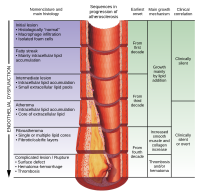
Photo from wikipedia
Purpose The upregulation of vascular cell adhesion molecule-1(VCAM-1) on vascular endothelium plays a great role in the progression of atherosclerosis (AS). In this study, ultrasound molecular imaging was performed to… Click to show full abstract
Purpose The upregulation of vascular cell adhesion molecule-1(VCAM-1) on vascular endothelium plays a great role in the progression of atherosclerosis (AS). In this study, ultrasound molecular imaging was performed to monitor the inflammation injuries in the onset and progression of atherosclerosis with microbubbles targeted to VCAM-1. Methods Mice deficient for the apolipoprotein E (ApoE-/-mice) with high-cholesterol diet were studied as an age-dependent model of atherosclerosis. At 8, 16, 24, and 32 weeks of age, contrast enhanced ultrasound (CEU) molecular imaging of proximal ascending aorta was performed with microbubbles targeted to VCAM-1. Plaque size, monocytes infiltration and the expression of VCAM-1 in the proximal ascending aorta were assessed by histology and western blot analysis, separately. Results In ApoE-/- mice, molecular imaging for VCAM-1 detected selective signal enhancement (P<0.01 versus non-targeted microbubbles) at all ages of ApoE-/- mice. Moreover, signals from targeted microbubbles increased from 8wks to 32wks age (P<0.05 for trend) in ApoE-/- mice, indicating the upregulation of VCAM-1 with the progression of atherosclerosis. Consistent with CEU imaging results, both western blot analysis and immunohistochemistry revealed the expression of VCAM-1 and monocytes infiltration were age-dependent in ApoE-/- mice. Conclusions CEU molecular imaging can be used to noninvasively detect the VCAM-1 expression on the endothelium in the progression of atherosclerosis. By investigating specific molecular biomarkers, it could help to monitor the inflammation and the progression of AS, which may in some extent contribute to the prediction of vulnerable plaque.
Journal Title: PLoS ONE
Year Published: 2017
Link to full text (if available)
Share on Social Media: Sign Up to like & get
recommendations!